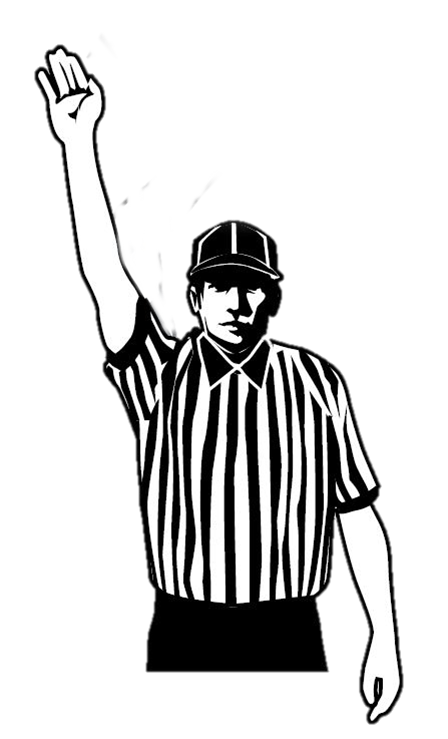
One of the things a crew needs to make sure it gets right is knowing whether the correct number of players are on the field. This is the responsibility of ALL officials: the Lead, Single and Trail, Referee, Umpire and Field Judge! Having an extra man is a huge advantage and having too few is a huge disadvantage. Whether it is the result of an illegal substitution, offsides, or illegal procedure, we need to recognize these fouls quickly and in the case of dead ball restarts, avoid them altogether. Not getting this right immediately undermines your credibility with the coaches, players and fans. It is literally our job to count the players. If we can’t do that, what else are we not doing? The other issue is that all of these games are on film and while it is a heck of a lot easier to catch all of these issues in slow motion, the fact is these mistakes are pretty glaring errors.
We need to get it right, ALL the time. And in order to do that we have to be vigilant and remember your ABCs! ALWAYS BE COUNTING! Count and then count again.
Transition and Settled Play
In transition, the New Lead has the initial count. The Single and Trail can count as they move up the field. As the Trail gets to the bottom of the wing line or the Single sets up on the cone, they should scan the field and count. Once all officials are in settled play, we all count again.
Count the offensive team first, as it is much easier to score with an extra man, you can try to avoid waving off a goal. Then count the defense. This means you might be late with a whistle or a flag on a defensive foul because you first counted the offense. That is fine, we need to make sure we get it right. And remember, a player running onto the field or over the midline and quickly returning doesn’t get a free pass. They need to be counted. Start with that player and then scan down to the box. They may be offsides or they may not be. But we need to count. Every time. ALWAYS BE COUNTING
There are some instances which should give you a hint you NEED to count again:
-
- Quick transition/fast break? Count again.
- Quick restart? Count again.
- Slow Restart? Count again.
- Someone run onto field and quickly goes back? Count again.
- Someone cross midline and quickly returns? Count again.
- Sidelines are screaming OFFSIDES! Count again.
- Restart following a timeout? Count again.
- Is one player not guarding anyone? Count again.
- Is there a double team but no one is open? Count again.
- Did a team just substitute? Count again.
- Contested play near midline? Count again.
- Penalty releasing soon? Count again.
- Haven’t counted in a while? Count again.
ALWAYS BE COUNTING.
Make Sure the Field is Set: Faceoffs and Extra Man
There a few instances were the crew CANNOT under ANY circumstance start play with an incorrect number of players: faceoffs and extra man. In these cases, the ball is dead and the crew must make certain the correct number of players are on the field. This always including those in the penalty box. Now, this does not mean that we wait for a team to run a player on the field, but we need to be aware of potential issues. By rule each team has 20-seconds to substitute players before play is restarted, but if you count early and realize a team is short you can let their bench know. “Blue you need a wing” or “Coach, count your players.” But you can’t address this unless you are ALWAYS BE COUNTING.
Faceoffs

You can’t give the ready point until you have the correct number of players!
Whether it is the opening faceoff or a faceoff following a goal in the third period, officials must have the correct number of players on the field. The primary responsibility here lies with the Wing official. The Wing official should:
-
- Quickly get to and stand at the bottom of the wing line and set up five yards into the middle of the field.
- Give the “Not Ready” Signal while they scan the field.
- Give the Timer On signal when the Face Off Official is close to the Faceoff x and has the ball.
- This indicates that you have started your 20-second timer.
- Loudly saying Timer on usually gets the players attention.
- Give the ready point to the Faceoff officials when the field is set with the correct number of players and is safe for play to restart.
The Wing official scans the field to make sure the correct number of players are on the field (including those in the penalty box). The Wing cannot signal to the Faceoff official to begin the faceoff until that requirement is met. If the 20-second timer goes off, a team has delayed the start of the game; award the ball to the opposing team. Just because you had three defendersor attackmen a few moments before, do not assume they are still there for the faceoff. A coach might decided to sub them out or pull the goalie. They might wander off the field for any number of reasons (injury, frustration, confusion) and their substitute isn’t aware they need to replace them. It only takes a few moments to scan below each restraining line and check for three defenders, three attackmen and a legally equipped goalie. Then check each wing and finally the two faceoff players. 10 and 10. We are ready for the Faceoff to begin. The Face Off official and Helper are focused on the two players who will participate in the faceoff. But even while they are waiting for the ready point from the Wing, they too can scan the field and double check. DO NOT ASSUME and ALWAYS BE COUNTING.
Man Up: Set the Field
Another situation that a crew cannot afford to screw up is a restart following a timer serving penalty. The crew needs to be particularly aware because one or more players are in the penalty box. The official relaying the penalty to the table needs to make sure the offending player is in the penalty area in front of the table, explain his foul and the time her will serve. A good habit to get into is to announce when the penalty will release. The other officials on the crew need to set the field.
-
- Where will play restart?
- Is there a Free clear?
- Find the ball.
- Make sure you only have one in play.
- Communicate the restart location to goalie and players.
- Hand ball to player and blow play in.
- How many players is each team allowed: ALWAYS BE COUNTING.
- Where will play restart?
Often times the ball is out of bounds following a missed shot or laying on the ground. Sometime two players will grab a ball from out of bounds. We need to make sure we only have one and it gets to the right spot. I prefer to hold on to the ball if I am managing the restart and hand it to the player just before I am ready to restart play while loudly announcing where the ball is to everyone.
It is ESPECIALLY important to count players in this situation. Lots of players are substituting. Extra man offensive and defensive units will usually sub onto the field. If there is more than one person serving a penalty, double and triple check. A coach might yell for his man-down and they run out, but if that team has two men in the box, one of those guys needs to come off the field for 6 on 4 instead of 6 on 5. Anticipate that this is going to be an issue and watch for it. Thi is not a time we want to penalize a team with a delay call for not being ready if we as officials did not do a good job of explaining the situation. SLOW DOWN. An official setting the field CANNOT give a ready signal until they know the field is set. ALWAYS BE COUNTING.
What to do When you Screw it Up
Each official on the field is responsible for getting the call right. Conducting a good pre-game, using solid mechanics, hustling to get to the right spots and constantly review the rules are all important. That being said, you are going to screw something up. What separates good officials from great ones is the ability to acknowledge their mistake and correct it as best they can. Once you do recognize an error has occurred, the most important thing you need to do is to SLOW DOWN. Lacrosse is a fast paced game and coaches and players only have a few seconds to make, sometimes, critical decisions of who should be on the field and where they should be.
If you happened to start play with the incorrect number of players and you quickly recognize the mistake, stop play immediately! Acknowledge the error. Reset the field; bring the ball back to the original restart spot, get the right number of players on the field, and decide if you need to reset the game clock (a few seconds off the clock is fine in the 2nd quarter, but with 34 seconds left in a tie game, reset the clock to 34!) However, if too much time goes by, you are in a bit of a bind. One team has been allowed to have a major advantage. At this point you need to take the ball away from the offense or throw a flag on the defense.
In either case, the takeaway here is that you could have avoided this by counting! ALWAYS BE COUNTING.
Pro Tips:
-
- Some officials like to count in pairs, others count in threes.
- Don’t point when you count, just makes you look confused.
- Know what time penalties release, makes it easier to keep track.
- Slow Down if you have multiple people in the box.
- Anticipate issues.
- Remember your ABCs: ALWAYS BE COUNTING.
